
Mr. Wonderful, Kevin O’Leary, and Frank Holmes recently took different side the gold (bullion) vs. gold stocks. Gold and gold stocks are two different asset classes and saying which one is better. One is a commodity (Gold) and the other is equity (Gold Stocks). It’s like comparing multiple championships winning athletes, Sydney Crosby (NHL), Lebron James (NBA), and Tom Brady (Football) and saying one of these players is the best athlete of all-time. Gold and gold stocks offer two different purposes for an investor’s portfolio.
WHY OWN GOLD BULLION?
You own gold in bullion form and keep it in storage as an insurance policy for your other financial assets. It acts as a counterbalance against other assets in your portfolio. Investors flock to gold as a “safe-haven” asset, just like cash because they aren’t willing to take on risk. Gold is like a cash position in your portfolio, you don’t get paid to own it. Think of Gold as another currency (cash position) that you have exposure too, and you can use it as a counterbalance against your riskier assets. If gold isn’t important, then why do Central Banks own it on their balance sheet? For investors, it’s a way of being your own Central Bank.
“I have a 5% weighting in gold. The GLD and physical bullion. Which I store and pay for the storage. The value of the commodity is whatever it is every day. Kevin O’Leary (Kitco)
Kevin O’Leary isn’t the only one who has gold as a counterbalance in their portfolio. Here is what Ray Dalio of Bridgewater thinks about gold:
“We can also say that if… things go badly, it would seem that gold (more than other safe haven assets like the dollar, yen, and treasuries) would benefit, so if you don’t have 5% – 10% of your assets in gold as a hedge, we’d suggest that you relook at this.” – Ray Dalio
Egyptian billionaire Naguib Sawiris investing half his net worth in gold
“And people also tend to go to gold during crises and we are full of crises right now. Look at the Middle East and the rest of the world and Mr. Trump doesn’t help.” (Marketwatch)
JP Morgan
“Underweight equities, long duration, long gold, and long the yen as Fed policy slows the economy and real rates collapse.” JP Morgan via ZH
GOLD TRADING LIKE A COMMODITY
After the dollar-gold window was broken in the 1970’s gold trades more like a commodity because it isn’t pegged to the US dollar. That is why gold, has better matched the cycle of the commodity booms since that time. Will it be treated again like before? We think that “Yes, gold will more than likely be pegged in some form to a currency at some point in the future”. Will it be more like past gold standards? Maybe, history repeats, just not exactly the same as before. It could be in a digital format because that is the way the world is going. We aren’t sure. But we follow the worldview that there are cycles and history repeats. We think that the mantra, “This could never happen” means it can happen again and probably will happen, just in a different twist. Everything has a time when it gets center stage. Gold standards will come, and then they will go. For now gold trades more like a commodity.
GOLD STOCKS AND CYCLE
When O’Leary says gold miners are horrible investments is a bit of hype and bluster.
O’Leary: “The history of mining has been abysmal… I don’t need to have a manager in the middle screwing up his capital cost allowance, not controlling his costs. (Kitco)
This is like saying all technology stocks are profitable like Apple.
The gold sector has one major commonality with every other sector. They are all cyclical! The question is, what cycle do they follow? Gold mining stocks and gold are part of the larger commodity cycle. If you understand the cycle, you understand that there is a time to buy and a time to sell. Gold miners generate an incredible amount of free cash flow once the sector has bottomed. Why? Management teams are forced to really look at their costs and focus on generating profits because investors demand it. Just like after the Dotcom bust, investors started to demand revenue, not just user growth. Let me say that again…Revenue! Profits were demanded as well.
Kevin O’Leary is right when he says “More and more investors are thinking the way I do. They are thinking about return of capital.”
But you are seeing it some darling tech stocks right now, focusing exclusively on growth with disregard for profits.
Look at Wayfair, an e-commerce company sells home goods online. Revenues have increased by more than 4X, yet $0 in profits over the past three years.
During the last gold peak, investors demanded growth in terms of ounces at all cost from management, and in the bottom, investors reversed course and realized profits are essential for survival. You know its approaching a top when its ounces at all costs. The technology sector has recently been like this, companies like Tesla(TSLA), Wayfair (W), where it has been growth at all costs. As the tech cycle turns, investors will demand profits from these companies, not just customer growth on Wayfair and auto deliveries from Tesla. This is a 100% guarantee because investors will get spooked when the cycle turns and expect profits. Right now, investors have been rewarding gold miners for delivering on production and showing profitability. In 2017, gold miners delivered record dividends. Gold miners are set to show strong revenues in 2018 because of the continued elevated gold price above $1,300.
“Tesla will be profitable & cash flow+ in Q3 & Q4, so obv no need to raise money,” tweeted Musk
OTHER WAYS TO INVEST THAN ROYALTY STOCKS & GOLD MINERS?
But there is more than one way to play the gold sector. I am always amazed, when I speak with portfolio managers and receive emails, they always bring up explorers, producers, and royalty stocks to invest in stocks. Seek where the profits are, and you will find the gold. Look at Apple, it generates the most profits in the cell-phone industry over the past 8 years, its revenue grew incredibly over that same time-period. So why not repeat the same process in the gold sector?
We think there is a better way to think about investing in gold & silver stocks, and commodity stocks in general. Does the company generate a percentage of their sales related to gold and silver? It opens you up to many different companies with exposure to other commodities or other industries. Seek companies that are growing revenue, but still, give you exposure to gold and silver.
We can see the day when companies that derive a percentage of their revenue from precious metals will be added to ETFs.
- Mining Services
-
-
- Major Drilling
- KGHM
- Swick Services
-
- Financial Services
-
-
- Sprott
- GoldMoney
- Canaccord Genuity
- CME Group
-
- Commodities Trading
-
-
- Glencore
-
- Refining & Distribution
-
- Johnson Matthey
- Umicore SA
Some of these companies are directly involved in operating mines, by providing useful services to the mining industry. While still being able to get exposure to the gold and silver. The additional value is you may be getting exposure to multiple commodities and in some case entirely different industries outside of mining that are growing.
YOU NEED REVENUE GROWTH
Frank Holmes taking a more factor-based approach, with one-factor, focused on revenue growth. This factor is important because revenue growth attracts investor money.
. “The royalty companies have done well and those stocks that basically show better revenue per share, reserves per share, production per share, they far outperform.” Holmes.
And if the company can grow revenue per share and/or cash flow per share this help share prices higher. Would you invest in a company that isn’t growing its revenue? This is why royalty stocks attract investors because they are able to grow revenue consistently over longer periods than the miners. The ability to add cash flowing royalties every year is like adding a new mine but a lot faster than a miner can.
Gold miners’ revenues are tied primarily to two items: 1. Production and 2. Gold Price. Investors are willing to pay up for anticipated growth in production because a new mine is starting up or an existing mine is ramping up for further production. Investors are not willing to pay up for growth, they will sell. The higher the expected growth potential, the higher the anticipated returns. But, watch out if the company slips up. Investors will punish the share price like we recently saw with Pretium Resources and New Gold. When the commodity price is falling faster than the production growth, this will take down all stocks in the sectors. This is why it’s important to focus on higher quality companies, with low AISC or have high operating margins. It minimizes your risks on the downside because they can maintain dividends, and their revenue is less impacted.
You can see why royalty and streaming companies like Franco-Nevada and Royal Gold are so popular because they offer fairly consistent revenue per share and cashflow per share growth relative to gold miners.
PROTECTION & GROWTH
Gold and gold stocks provide investors with two very different sets of risks and opportunities to protect and grow their wealth. You own gold primarily as an insurance policy against your portfolio and the financial system. You own gold stocks as a way to potentially increase your wealth by focusing on growth, management ownership and catalysts. Two different asset classes that are part of the overall portfolio. By understanding the cycle that they both follow, you can enjoy the ups and take money off the table when the crowd is all in.
Written by Paul Farrugia, BCom. Paul is the President & CEO of First Macro Capital. He helps his readers identify mining stocks to hold for the long-term. He provides a checklist to find winning gold and silver miner stocks and any commodity producer.
Disclaimer:
The information contained herein is obtained from sources believed to be reliable, but its accuracy cannot be guaranteed. It is not designed to meet your financial situation – we are not investment advisors, nor do we give personalized investment advice. The opinions expressed herein are those of the publisher and are subject to change without notice. It may become outdated, and there is no obligation to update any such information.
Investments recommended in our publications, blog posts, emails, online communications, or any online contents published by any party of First Macro Capital and its affiliated companies should be made only after consulting with your investment advisor and only after reviewing the prospectus or financial statements of the company in question. You should not make any decision based solely on what you read here.
First Macro Capital writers and publications do not take compensation in any form for covering those securities or commodities. First Macro Capital employees and agents of First Macro Capital and its affiliated companies own some of the stocks mentioned in this article, prior to the writing of this article.
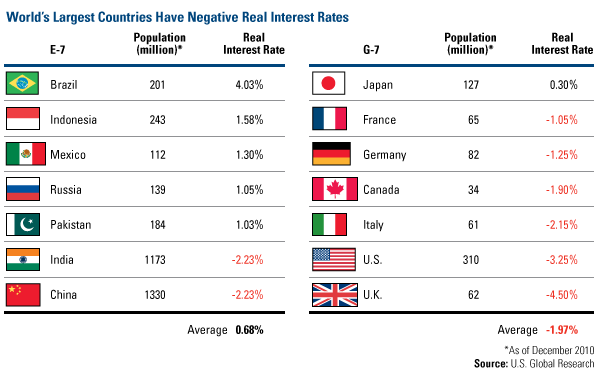
Negative real interest rates occur when the inflationary rate, or CPI, is greater than the current interest rate. A quick account of the G-7 and E-7 countries shows that the majority have negative real interest rates.
Across the developed G-7 countries, British citizens are the worst off with real interest rates in the U.K. sitting at negative 4.5 percent. U.S investors aren’t doing much better with rates at negative 3.25 percent and the Fed has all but guaranteed rates will remain there. Only Japan has a positive real interest rate among the G-7 and that rate is barely above zero.
Conversely, the most populous nations making up the E-7 have mostly positive real interest rates. However, the grouping’s grandest economic powerhouses, China and India, have negative real interest rates sitting around negative 2 percent.
Simply put, investors in those countries who have parked their savings in cash and low-yielding investments, such as Treasury bills and money market accounts in the U.S., are actually losing money due to inflation.
VTB Capital’s Andrey Kryuchenkov told The Wall Street Journal this week that, “Central banks are diversifying, and it has intensified to a rate that nobody had expected.” Latest estimates predict global central banks will purchase between 475-500 tons of gold in 2011.
This amount of capital flowing into gold has the potential to push prices up a level in 2012. John Mendelson from ISI Group sees gold prices reaching $2,200 an ounce during the first six months of 2012.
While real interest rates look to remain in the red for the foreseeable future, many of these same countries are printing record amounts of “green” with accommodative monetary policies. Bloomberg reports that global money supply (M2) is “set to increase the most on record in 2011.”
The reason global central banks have shifted the printing presses into overdrive is simple: they need the money. Frank Giustra reminded us of this new reality in an op-ed piece for the Vancouver Sun last week. Frank writes:
“The bottom line is that the money needed to bail out Europe and to fund America’s spiraling debt and future unfunded obligations is in the ten of trillions. IT DOES NOT EXIST. It has to be created by printing money in massive quantities, and despite all the rhetoric you will hear against such policies, in the end it’s the path of least resistance. Printing money is an invisible tax on savings, much easier to initiate, than, say, raising taxes or cutting back on services and entitlements.”
From the article entitled, “You Can’t Print More Gold” by Frank Holmes. Frank Holmes is chief executive officer of U.S. Global Investors – a registered investment adviser that manages approximately $2.8 billion. The information provided herein has been provided to MiningFeeds.com by the author and, as such, is subject to our disclaimer: CLICK HERE.
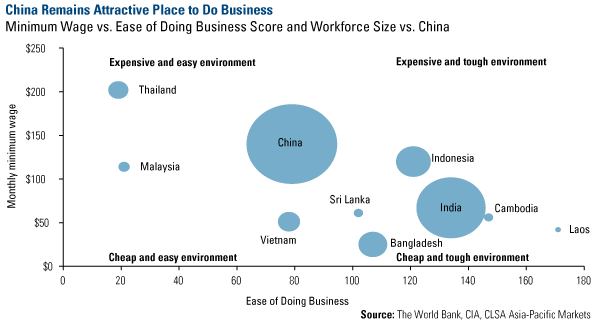
At the CLSA AsiaUSA Forum in San Francisco earlier this month, numerous opportunities for U.S. businesses in China were discussed. Factors affecting growth in China are the Asian middle class, an increasing urbanization rate, and additional disposable income. The latter has been partially spurred by recent increases in wages. In fact, many people in China saw their wages rise 20 to 30 percent last year.
However, while these wage increases have been positive to the Chinese consumer and the companies which sell the goods, they have prompted many people to ask me how rising wages affect China’s status as a low-cost manufacturing hub for the world. Does this reduce the profitability of companies that expect to continue to benefit from the country? And, will China continue to drive resource demand?
This is where CLSA’s more balanced view of China’s business landscape is not only helpful, but essential. It is not enough to look at rising wages to appreciate how attractive China is for businesses. To get a better understanding, let’s compare three factors—the World Bank’s Ease of Doing Business score, minimum wage and workforce size—across several Asian markets. The World Bank annually analyzes regulations that either enhance or constrain business activity among 183 economies. For a business that wants to expand into different markets, this report is helpful in determining the ease or difficulty in obtaining construction permits, electricity and credit, as well as hiring workers and trading across borders.
On the World Bank’s scale, the business environment is easier in Thailand and Malaysia than in China and Vietnam, and companies would find it even more difficult to expand their businesses into Indonesia, India and Cambodia. However, Indonesia, India and Cambodia have cheaper labor markets than China or Thailand. But of all of these countries, China offers the largest labor market. CLSA says China makes for an “appealing hub for manufacturing” when you evaluate its unique combination of strengths together.
In addition, China’s workforce is better educated and more highly skilled compared to other Southeast Asian countries, says CLSA. China was also named the “world’s most connected economy” by the United Nations Conference on Trade and Development’s Liner Shipping Connectivity Index, when it comes to how integrated global shipping networks are to enable worldwide trade. The country also has superior infrastructure and trade connectivity compared to many emerging markets, “even occasionally besting developed economies,” says CLSA.
From the article entitled, “With Rising Wages, Will China Remain a Manufacturing Hub?” by Frank Holmes. Frank Holmes is chief executive officer of U.S. Global Investors – a registered investment adviser that manages approximately $2.8 billion. The information provided herein has been provided to MiningFeeds.com by the author and, as such, is subject to our disclaimer: CLICK HERE.
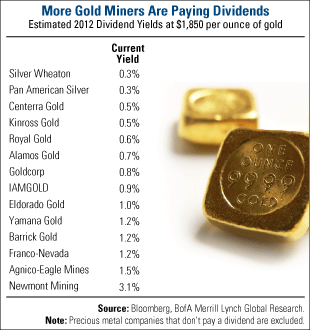
With money markets and Treasuries yielding next to nothing these days, investors are finding income in new places. One area those investors should consider is gold mining. With gold rising in value, mining companies are reaping record profit margins, yet the stock prices are depressed due to lack of investor interest. A solution for both gold companies and investors may be dividends, specifically gold-linked dividends.
Several top-tier gold producers that are benefiting from higher gold prices have begun to share a portion of their profits with shareholders via a dividend payout. Thirteen of the world’s largest gold producers are expected to pay nearly $2 billion in dividends this year, according to MineFund, making it the largest payment in gold stock history. The Financial Post also reported that miners’ dividend payments are up 75 percent on a year-over-year basis, compared to a 26 percent increase in 2010.
Yamana Gold (TSX:YRI) is just one of several large producing miners to report increased revenues, expanding cash flows and record adjusted earnings. Because of the company’s strong balance sheet, Yamana increased its dividend for the second time this year to $0.20 per share annually. When discussing the enhanced payouts, CEO Peter Marrone cited that the company “continued to focus on delivering growth across all measures, enhancing shareholder value and generating significant cash flow in the third quarter.”
The latest payout represents a 67 percent increase over the past 12 months and the second increase this year.
Other miners, such as Newmont Mining (NYSE:NEM), have implemented a gold-linked dividend, which means that the amount of the dividend the shareholder receives will be linked to the average price of gold. As the yellow metal trades higher, the company would increase dividends paid out to its investors. Conversely, if gold falls in value, dividend payouts would decrease.
Eldorado Gold (TSX:ELD) has also come out with a similar dividend policy, linking dividends to the price of gold. As shown in the chart below, Eldorado Gold anticipates its next dividend payout will be 67 percent higher than the previous quarter.
Barrick Gold (TSX:ABX) also announced a third quarter dividend increase during its earnings release. Over the past five years, the company has increased its dividend by more than 170 percent on a quarterly basis. The company’s latest dividend—$0.15 per share— represents a 25 percent increase from the prior quarter.
Barrick estimates its third quarter gold cash margins have increased by 55 percent on a year-over-year basis, driven by the company’s leverage to higher gold prices. The company says it will continue to offer its shareholders a rising income stream while also expanding operations in Pueblo Viejo, Pascua-Lama and Nevada.
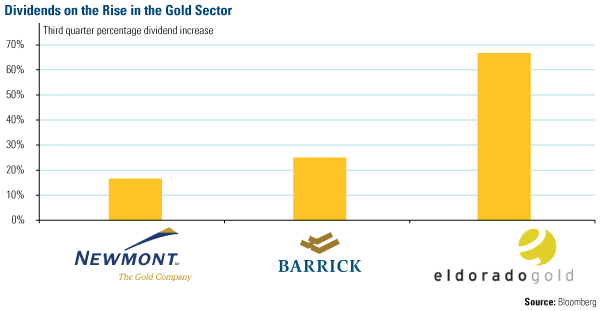
While the share prices of these miners have been punished in 2011, increasing dividends allow investors to get “paid to wait” for the market to turn around. The dividends are a cash incentive for investors to hold shares of the company and allow them to participate in rising earnings. We like that idea.
From the article entitled, “Get Paid to Play Gold” by Frank Holmes. Frank Holmes is chief executive officer of U.S. Global Investors – a registered investment adviser that manages approximately $2.8 billion. The information provided herein has been provided to MiningFeeds.com by the author and, as such, is subject to our disclaimer: CLICK HERE.
The ongoing crisis in Europe has not only affected emerging markets, it has also negatively influenced the price of many commodities. UBS states that an “escalating bank funding stress in Europe is forcing a profound deleveraging process.” As U.S.money markets have been forced to pull their funds out of Europe, the short-term financing markets, which include commercial paper and trade finance, have been stressed and have weakened industrial and commercial credits. Companies involved in the trading and movement of commodities have had to run their businesses for cash, resulting in the disruption of commodity shipments.
This is clearly a negative for commodity prices in the short-term, but we believe the effects have already been priced into the market. Also, UBS indicates that this has pushed commodity inventories to “unsustainably low levels” and once credit conditions improve, demand should increase.
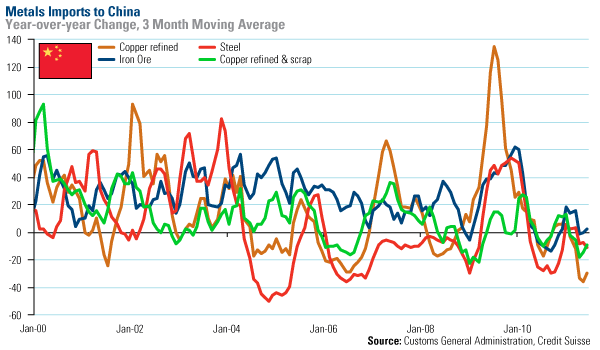
Imports of major metals to China are already running low, says Credit Suisse. While the year-over-year change in iron ore imports is at the same level as last year, copper imports are at an 11-year low, based on its year-over-year percent change.
So, if you’re counting the market’s cards, you can see that nearly all of the bear market’s aces have been played. Now that China’s PMI has turned upward, along with the potential for China’s monetary policy easing, it’s possible we’ll see a run in commodities through Chinese New Year.
From the article entitled, “Do Bullish Investors Have an Ace in the Hole?” by Frank Holmes. Frank Holmes is chief executive officer of U.S. Global Investors – a registered investment adviser that manages approximately $2.8 billion. The information provided herein has been provided to MiningFeeds.com by the author and, as such, is subject to our disclaimer: CLICK HERE.
Since hitting $1,900 an ounce through the beginning of October, gold has declined nearly 11 percent. Over the same timeframe, the NYSE Arca Gold Miners Index lost almost 13 percent. That’s a closer performance correlation than the roughly 3-to-1 gold equities to bullion ratio we’ve historically seen and could mean the miners are finally closing the gap.
However, TD Securities Equity Research points out this interesting fact: Over a period of 18 months prior to hitting $1,900, gold rose 79 percent but TD’s basket of gold equities only increased 57 percent. The firm says this performance gap “ranks as the worst relative performance of gold equities to gold since 2001.” During the July through September period of 2008, TD Securities’ universe of gold equities declined 46 percent, while gold bullion only lost 24 percent. In October through November of 2008, the same gold equities lost 37 percent; while gold decreased 22 percent.
What’s behind today’s record disparity?
Part of it may be due to the underperformance of the explorers and developers, which, TD says, “have been hit the hardest.” The chart below shows gold miners by capitalization and their returns since April 2011. Explorers and developers have declined the most, losing 21 percent, small- and mid-cap producers have declined 6 percent and large producers lost 5 percent.
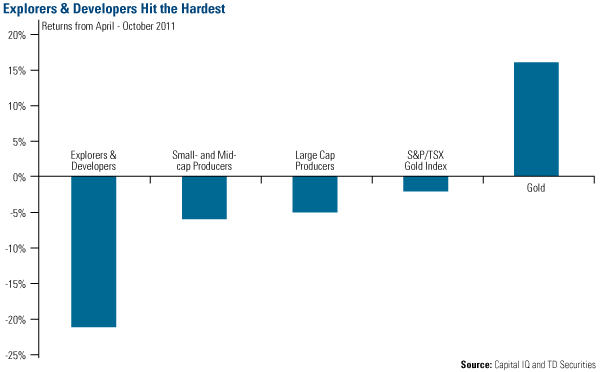
Because of the dramatic price decline in these early-stage companies, investors have the opportunity to purchase explorers & developers (E&D), often referred to as juniors, at about half of the company’s net asset value (NAV). In simplest terms, the NAV means assets minus liabilities. In fact, you can see from the chart that the current price-to-NAV level for E&D equities is sitting near record low levels…levels not seen since the financial crisis of 2008.
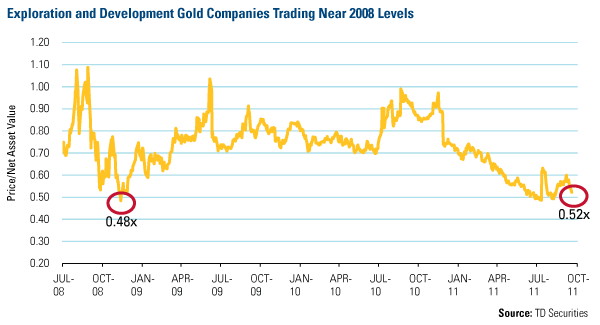
TD found that in seven of the past 10 rallies, gold equities beat gold—averaging a beta of 1.4 times. Looking over the next year or so, we believe the smaller gold miners may be poised to outperform this time. As TD says, “on a rebound, we expect the best performing equities to be among the ranks of the explorers and developers.”
From the article entitled, “Which Gold Miners Have Largest Upside?” by Frank Holmes. Frank Holmes is chief executive officer of U.S. Global Investors – a registered investment adviser that manages approximately $2.8 billion. The information provided herein has been provided to MiningFeeds.com by the author and, as such, is subject to our disclaimer: CLICK HERE.
U.S. stock markets suffered through the worst quarter since 2008, with the S&P 500 Index dropping nearly 14 percent for the quarter; more than half of this drop occurred in September alone. Only 54 companies in the S&P 500 saw positive returns during the month, while more than 200 dropped at least 20 percent, TheStreet.com reports.
This week, we’d like to point out three reasons investors should consider remaining in equities or reassessing whether to sit on the sidelines: 1. Investor sentiment is signaling the market is overextended to the downside 2. Stocks are trading well below historical valuation trends 3. S&P 500 dividend yields are higher than the 10-year Treasury yield.
1) Investor Sentiment at Panic Level. Citigroup’s Panic/Euphoria model, a proprietary combination of nine facets of investor beliefs and fund managers’ actions, has been in “panic” territory since mid-August. Historically, overly bullish territory (Euphoria) generally signals a market correction is on the way, while a recovery arrives when sentiment is overly pessimistic (Panic). The current panic level “generates a near 90 percent chance of higher equity prices in six months and a 97 percent probability of teen-like gains in the next 12 months,” says Citigroup.
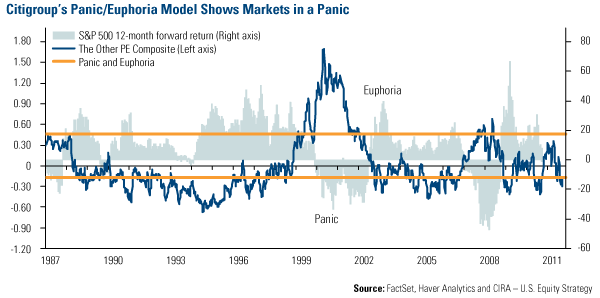
Historically, the average market bounce is 8.9 percent the following six months and 17.3 percent the following year after falling below the panic line. It’s worth pointing out that gauging investor sentiment isn’t an exact science. Markets reached a panic at the end of June and a rebound never came to fruition. However, Citigroup says it does send a “fairly clear contrarian message of opportunity.”
2) Equities Appear to Be Underpriced. One positive result of the selloff is that many equities now appear to be priced at attractive levels. When a stock trades at fair value, that means the equity is “fairly” priced based on a discounted cash flow (DCF) model. DCF uses future cash flow projections a company may earn and then discounts the projections based on the cost of capital. To put it plainly, the DCF is what the company is expected to earn subtracted by what it will cost to generate those earnings, plus the time value of money (TVM). TVM means that money is worth more today than in the future. This chart plots the fair value of the roughly 1,300 U.S.-listed stocks covered by Morningstar. A ratio of one means a company is equal to its fair value. Today’s ratio is 0.81 and is approaching the lows we saw during the worst of the financial crisis in 2008. The current ratio implies roughly 20 percent upside to current equity prices.
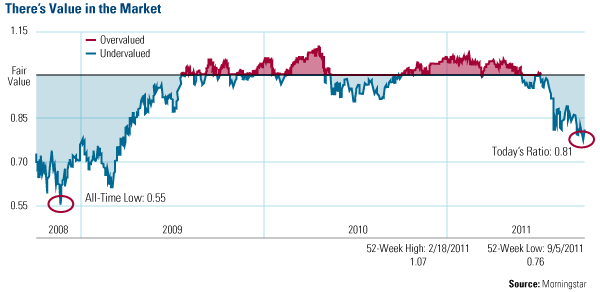
This doesn’t mean equity prices have bottomed, but even pessimistic investors can see that many companies are trading at deep discounts relative to their expected cash flows. BCA Research looked at equity valuations from another angle. The firm analyzed the trailing price-to-earnings (P/E) ratio of the S&P 500 versus the current yield on a 10-year Treasury bill over the past 50 years. Historically, there is an inverse relationship between the two, BCA says, meaning that higher yields on a 10-year Treasury meant lower P/E ratios for equities. This makes sense, because when investors can receive a substantial return from a “safer” government note, there is less incentive to buy equities that may carry a greater amount of risk and vice versa.
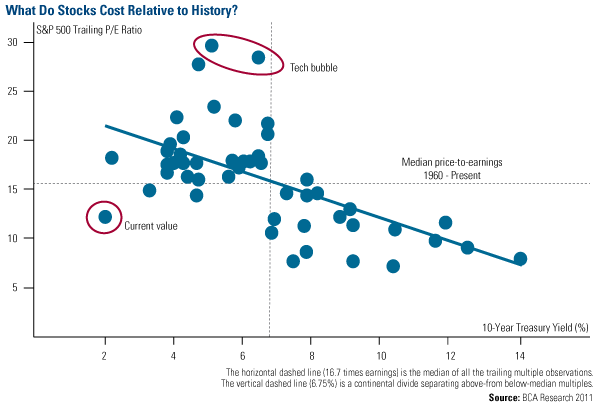
You can see from these plot points that today’s relationship between P/E multiples and yields is a “clear outlier” to historical trends. The other rare instance where values ventured so far from the trendline was during the Tech bubble (when equities were overvalued), but that is the exact opposite than what we have today. BCA Research assesses the market this way: “The multiple-rates analysis highlights that stocks are cheap. However, we do not rule out the possibility that they can get cheaper. Bottom line: If, consistent with our base-case expectation, the U.S. averts a recession, equities are inexpensive enough to provide investors with an attractive risk-reward profile.”
3) Dividend Yields Appear Attractive. Another “buy signal” for stocks we’ve highlighted many times in the past, and now discussed by J.P. Morgan last week, is that investors can receive a higher yield from stocks in the S&P 500 than from a 10-year Treasury. The current dividend yield for the S&P 500 is currently 0.67 percent higher than that of a 10-year Treasury, implying investors could receive a higher return with stocks just by receiving the dividend.
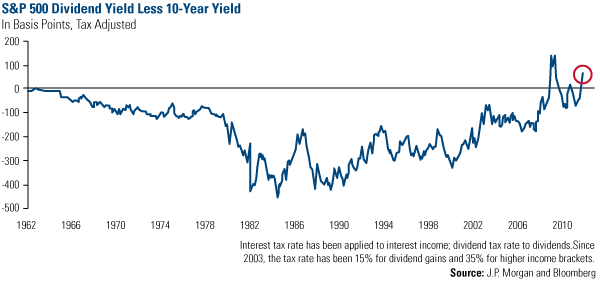
Only Fools Rush In as Elvis sang so many years ago, “Wise men say, only fools rush in.” Now may not be the time for investors to be brave and overload themselves with unnecessary risk. The eurozone continues to struggle to find a way out of the debt mess created by Greece and others, and unemployment in the U.S. stubbornly remains above 9 percent, causing the economy to sputter. Both of these risks could torpedo an economic recovery before it leaves the harbor. The King’s expression also applies to those investors hiding their cash under their mattresses. Investors must evaluate their individual financial situations to balance risk and uncertainty with opportunity, while keeping their focus on the long term. That’s no easy task but strategies such as dollar-cost averaging can at least get them back on the road again. No one knows what tomorrow will bring, but varied indicators are signaling now is the time to be contrarian and take advantage of the opportunity the recent selloff has given long-term investors.
From the article entitled, “Can Markets Find the Road Back to Positive Territory?” by Frank Holmes. Frank Holmes is chief executive officer of U.S. Global Investors – a registered investment adviser that manages approximately $2.8 billion. The information provided herein has been provided to MiningFeeds.com by the author and, as such, is subject to our disclaimer: CLICK HERE.
Demand for gold isn’t only coming from the residents of China and India. There’s been a huge sentiment shift among central banks as well. Toussaint noted how, after many years of selling, central banks have become net buyers of gold. He says, “Western Central banks have essentially shut the tap off, and the vast majority of the buying is coming from Eastern central banks.”
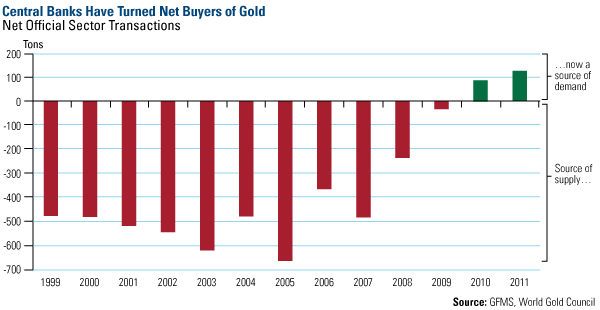
In just the first half of this year, official sector purchases are up three-fold over the 2010 total to 216 tons, accord to the GFMS report. GFMS says the rise is largely due to low sales levels from Central Bank Gold Agreement (CBGA) signatories and the International Monetary Fund (IMF) completing its sales program at the end of 2010. In addition, other countries have gobbled up gold in an effort to diversify reserves away from the U.S. dollar. Scotia Capital estimates central banks’ total purchases of gold will reach 248 tons by year-end.
Some of the big buyers have been Mexico (whose central bank purchased roughly 100 tons of gold earlier this year), Korea (purchased 25 tons in June), Thailand (purchased nearly 19 tons in June) and Russia (which has purchased over 50 tons of gold from its domestic market year-to-date).
Toussaint says Eastern central banks are “catching up with the rest of the world” because their current allocation is tiny right now. However, whenever the WGC discusses these buying habits with the central banks of Korea, Taiwan and other Asian countries, they consistently say that they are interested in gold, and looking to hold it over the long-term. In other words, he says, this is not a “knee-jerk reaction to the direction of the dollar.”
GFMS also believes that this could be just the beginning. In a release announcing the report, Philip Klapwijk, Global Head of Metals Analytics at GFMS, said, “we are in essence in chapter three of the central bank story—we’ve left behind a period of heavy net sales, then a short period of neutrality and we’re now in a new environment of heavy buying.”
From the article entitled, “Perfect Storm Creates Tidal Wave of Gold Demand” by Frank Holmes. Frank Holmes is chief executive officer of U.S. Global Investors – a registered investment adviser that manages approximately $2.8 billion. The information provided herein has been provided to MiningFeeds.com by the author and, as such, is subject to our disclaimer: CLICK HERE.
If you would like to receive our free newsletter via email, simply enter your email address below & click subscribe.
CONNECT WITH US
Tweets
Tweet with hash tag #miningfeeds or @miningfeeds and your tweets will be displayed across this site.
MOST ACTIVE MINING STOCKS
Daily Gainers
 New Age Exploration Limited New Age Exploration Limited |
NAE.AX | +33.33% |
        |
CASA.V | +30.00% |
    |
VKA.AX | +28.57% |
    |
CTO.AX | +25.00% |
        |
BSX.TO | +22.22% |
        |
ANK.V | +21.74% |
        |
SRI.V | +20.00% |
        |
NEV.V | +20.00% |
        |
IB.V | +18.18% |
        |
SLL.V | +16.42% |

 Follow us on Twitter
Follow us on Twitter Become our facebook fan
Become our facebook fan







